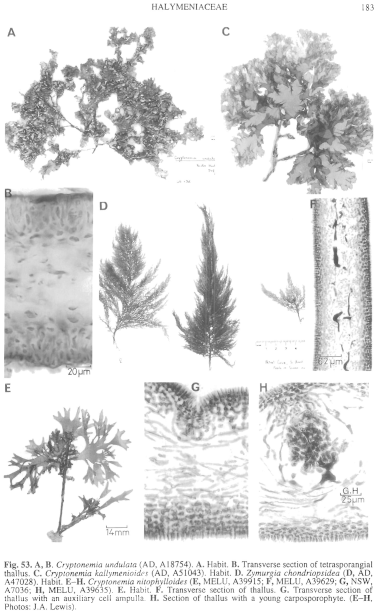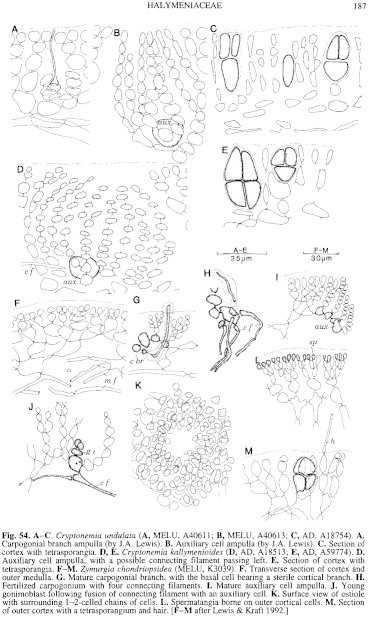|
|
|
|
|
|||||||||||
|
Electronic Flora of South Australia Species Fact Sheet
Phylum Rhodophyta – Class Florideophyceae – Order Gigartinales – Family Halymeniaceae
Selected citations: De Toni 1905: 1610. Harvey 1862: pl. 205. Kützing 1869: 11, pl. 31c, d. Scott, Wetherbee & Kraft 1982: 249, figs 27–35.
Synonym
Phyllophora obtusa var. crispata Sonder 1848: 172.
Thallus (Fig. 53A) medium red to red-brown fading to greenish-yellow, membranous and cartilaginous, 5–22 cm high, with strongly undulate upper branches, irregularly laterally branched, 5–10 mm broad, 80–180 nm thick, with rounded apices and more or less smooth margins, with branched stalks 1–10 cm long and 1–2 mm broad formed by loss of the lamina from the midrib which extends into the lower part of the fronds; proliferations from midrib common. Holdfast discoid to conical, 2–6 mm across; epilithic. Structure (Fig. 53B) of a relatively narrow cortex 4–6 cells thick, outer cells 3–4 nm across and slightly elongate in section, inner cells ovoid and up to 10–14 µm across, stellate cells absent or rare; midrib formed by development of vertical rows of cells from the outer cortical cells. Medulla broad, of densely entwined filaments 4–6 nm in diameter, with prominent refractive ganglioid cells with relatively straight arms. Rhodoplasts discoid, several per cell.
Reproduction: Sexual thalli probably dioecious, female ampullae in upper branches, arising in outer medulla. Carpogonial branch ampullae (Fig. 54A) small, with 1–5 secondary filaments. Auxiliary cell ampullae (Fig. 54B) larger, with several long secondary filaments reaching almost to the thallus surface. Carposporophytes 80–160 µm across, with a persistent basal auxiliary cell, slight involucre and small ostioles. Spermatangia not observed.
Tetrasporangia (Fig. 53B, 54C) sparsely scattered in the outer cortex in an irregular tissue 3–4 cells thick developed from the original outer cortical cells, 20–30 µm long and 8–12 (–15) µm in diameter, irregularly cruciately divided.
Type from Port Phillip, Vic., Sept. 1852; lectotype in MEL, 696599.
Selected specimens: Tarkoola Beach, Geraldton, W. Aust., drift (Kraft, 9.x.1990; MELU, A39799). Elliston, S. Aust., 7–8 m deep (Shepherd, 27.x.1971; AD, A42440). Port Victoria, S. Aust., sublittoral (Gibson, 25.ix.1949; AD, A11244). Estrees Bay, Kangaroo I., S. Aust., reef pool (Womersley, 11.i.1950; AD, Al2682). Victor Harbor, S. Aust., drift (Womersley, 23.v.1953; AD, A18754). Point Lonsdale, Vic., 1–2 m deep (J. Lewis, 15.ii.1979; MELU, A40576). Queenscliff, Vic., drift (Womersley, 8.iv.1959; AD, A22836). Portsea, Vic., 3–5 m deep near jetty (Kraft & Saunders, 24.iii.1992; MELU, A40611, A40613). Crawfish Rock, Westernport Bay, Vic., 4–5 m deep (Watson, 26.iv.1969; AD, A34315).
Distribution: India (?) (Boergesen 1932, p. 125). Geraldton, W. Aust., to Westernport Bay, Vic.
Taxonomic notes: Sonder (1855, p. 516) gave two collection dates with his type description, Sept. 1852 and Nov. 1853. A Sept. MEL specimen, with Sonder's notes, is selected as lectotype. MEL contains no Mueller specimens of Nov. 1853 but has several of Jan. 1853, and Mrs Doris Sinkora (pers. comm.) believes the Nov. 1853 is an error since Mueller was on an inland trip from 1 Nov. 1853 to mid April 1854.
C. undulata is similar in habit to the type species and appears to agree generally in structure and reproduction, as far as the type is known (Chiang 1970, p. 52, pl. 6a). The type species appears to have a thinner thallus than C. undulata, which occurs from about 1 m deep (shaded) to 38 m deep, on coasts of moderate wave action.
Harvey distributed this species as Cryptonemia luxurians (a Brazilian species) in his Alg. Aust. Exsicc. 402F from Port Phillip, Vic. The holotype of Phyllophora obtusa var. crispata Sonder from W. Aust. (Preiss) is in MEL, 501414, and is conspecific with C. undulata
References:
BOERGESEN, F. (1932). Some Indian Rhodophyceae, especially from the shores of the Presidency of Bombay. II. Kew Bull. 1932(3), 113–134, Plates II-V.
CHIANG, Y.-M. (1970). Morphological studies of red algae of the family Cryptonemiaceae. Univ. Calif Pubis Bot. 58, 1–83, Plates 1–10.
DE TONI, G.B. (1905). Sylloge Algarum omnium hucusque Cognitarum. Vol. 4. Florideae. Sect. 4, pp. 1523–1973. (Padua.)
HARVEY, W.H. (1862). Phycologia Australica. Vol. 4, Plates 181–240. (Reeve: London.)
KÜTZING, F.T. (1869). Tabulae Phycologicae. Vol. 19. (Nordhausen.)
SCOTT, F.J., WETHERBEE, R. & KRAFT, G.T. (1982). The morphology and development of some prominently stalked southern Australian Halymeniaceae (Cryptonemiales, Rhodophyta). I. Cryptonemia kallymenioides (Harvey)Kraft comb. nov. and C. undulata Sonder. J. Phycol. 18, 245–257.
SONDER, O.W. (1848). Algae. In Lehmann, C., Plantae Preissianae. Vol. 2, pp. 161–195. (Hamburg.)
SONDER, O.W. (1855). Algae annis 1852 et 1853 collectae. Linnaea 26, 506–528.
The Marine Benthic Flora of Southern Australia Part IIIA complete list of references.
Publication:
Womersley, H.B.S. (14 January, 1994)
The Marine Benthic Flora of Southern Australia
Rhodophyta. Part IIIA, Bangiophyceae and Florideophyceae (to Gigartinales)
Reproduced with permission from The Marine Benthic Flora of Southern Australia Part IIIA 1994, by H.B.S. Womersley. Australian Biological Resources Study, Canberra. Copyright Commonwealth of Australia.
Illustrations in Womersley Part IIIA, 1994: FIGS 53A, B, 54 A–C.

Figure 53 enlarge
Fig. 53. A, B. Cryptonemia undulata (AD, A18754). A. Habit. B. Transverse section of tetrasporangial thallus. C. Cryptonemia kallymenioides (AD, A51043). Habit. D. Zymurgia chondriopsidea (D, AD, A47028). Habit. E–H. Cryptonemia nitophylloides (E, MELU, A39915; F, MELU, A39629; G, NSW, A7036; H, MELU, A39635). E. Habit. F. Transverse section of thallus. G. Transverse section of thallus with an auxiliary cell ampulla. H. Section of thallus with a young carposporophyte. (E–H, Photos: J.A. Lewis).

Figure 54 enlarge
Fig. 54. A–C. Cryptonemia undulata (A, MELU, A40611; B, MELU, A40613; C, AD, A18754). A. Carpogonial branch ampulla (by J.A. Lewis). B. Auxiliary cell ampulla (by J.A. Lewis). C. Section of cortex with tetrasporangia. D, E. Cryptonemia kallymenioides (D, AD, A18513; E, AD, A59774). D. Auxiliary cell ampulla, with a possible connecting filament passing left. E. Section of cortex with tetrasporangia. F–M. Zymurgia chondriopsidea (MELU, K3039). F. Transverse section of cortex and outer medulla. G. Mature carpogonial branch, with the basal cell bearing a sterile cortical branch. H. Fertilized carpogonium with four connecting filaments. I. Mature auxiliary cell ampulla. J. Young gonimoblast following fusion of connecting filament with an auxiliary cell. K. Surface view of ostiole with surrounding 1-2-celled chains of cells. L. Spermatangia borne on outer cortical cells. M. Section of outer cortex with a tetrasporangium and hair. [F–M after Lewis & Kraft 1992.]

|
Email Contact: State Herbarium of South Australia |

|